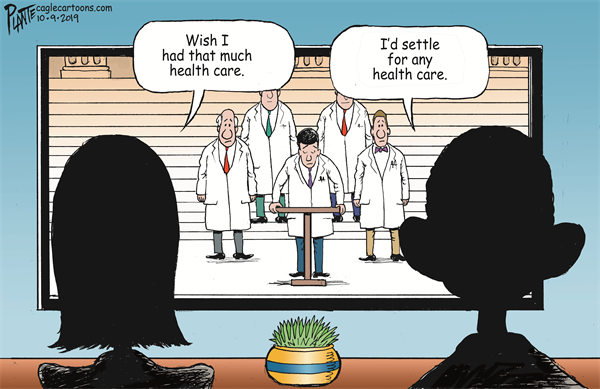The essay was submitted by Arthur C. Donart, Ph. D.
 Stop and think about it. Would “for-profit” Fire Protection Districts be workable? Probably not. If they were, you would see private equity firms buying up Fire Departments. That’s not happening. A Fire Department has to [exist and] be ready in the event there is a fire You can’t just wait until there is a fire and then create a Fire Department.
Stop and think about it. Would “for-profit” Fire Protection Districts be workable? Probably not. If they were, you would see private equity firms buying up Fire Departments. That’s not happening. A Fire Department has to [exist and] be ready in the event there is a fire You can’t just wait until there is a fire and then create a Fire Department.
By the same token, you can’t just wait until there is a pandemic and then build a Health Care System, capable of taking care of a health crisis. Our for-profit health care system is too expensive and inadequate.
First, examine some of the factors driving up the cost and drilling down the care. The CBS documentary 60 Minutes recently broadcast a segment on how a hospital business managed to buy up its competitors and establish a monopoly, allowing them to triple the average cost of a hospital stay. The State’s Attorney General of California took the firm to court. Rather than admit guilt, Sutter Health agreed to pay a $533 million dollar fine and revise their pricing.
Another factor is what is called “Surprise Billing.” When an ambulance takes you to an Emergency Room, you are unlikely to be able to designate the hospital to which you are being transported, especially if there is only one available. On arrival, someone will provide your insurance card. Usually there is a considerable amount of co-pay that you, or a family member, realize/realizes that you are responsible to pay. However, because a private equity investment fund owns the emergency group staffing at the hospital’s Emergency Room, and they are “out of network,” you get the shock of a much higher bill, payable to this medical group.
Investors are looking for “big bucks.” In 2009, about $250 million in private equity investment was in health care, but by 2018 the amount has increased to $10.4 billion dollars. Why? It is, because most investors put their money where they can get the greatest return on their investment. These are private (billionaires’) funds. In the recently passed COVID-19 Relief Bill, surprise billing was outlawed. This left insurance companies to bargain the charge or go to arbitration–but that does not take effect until 2022. The preferred solution was simply not to allow the charges to exceed 10% of the median cost in their geographical area, which would likely be less costly. Unfortunately, Congressman Richard Neal (D) chairs the House Ways and Means Committee; he receives considerable campaign contributions from these health care private equity firms. Neal would not go along with the less-costly solution. That will, of course, results in higher insurance premiums.
Finally, it is good to note that health insurance companies also add a huge amount to the cost of health care, through inefficiency, duplication, and/or high CEO compensation packages. Each company has a different code for billing and different systems for processing claims, which eat up nearly 28 cents out of every health care dollar. The Nation (December 14-21, 2020) reported that “health care executives are receiving exceptional payouts. Of the top 100 highest paid US CEOs in 2019, 19 [of these CEOs] head health care companies.”
The Nation gives the following examples:
- 1. Gilead Sciences CEO Daniel O’Day gets $29.1 million
- 10. HCA Healthcare CEO Samuel Hazen gets $17.2 million
- 12. Eli Lilly CEO David Ricks gets $16.6 million.
Unfortunately, health care cost in the for-profit environment prices a large portion of our citizens out of adequate care. It also is totally inadequate to meet our needs.
The COVID-19 pandemic has laid bare these inadequacies. Watching to National news, we see hospitals turning away patients and putting them in a hallway or the gift shop, because they lack beds. In 1975 hospitals had 1,465,828 hospital beds available. By 2018 the number of beds available had declined by 567,867 beds. Empty beds do not make money. Therefore, a for-profit hospital is not going to allow for an “excess” of available beds.
Not only is there half-a-million less capacity for sick or injured patients, there fewer hospitals. “Since 2005, more than 170 rural hospitals have closed Nationwide (The Nation).” According to statistics from the NIHCM Foundation, there have been 1095 hospital consolidations from 2006 to 2018. This consolidation results in price increases of 20-40%. It also results in concentrating facilities in more prosperous areas. That leaves those living in poor neighborhoods without access to care, unless they travel a considerable distance. These neighborhoods are usually inhabited by black, brown, and immigrant citizens.
The COVID-19 pandemic has amply shown that everyone’s health matters. Viruses are not racists, and they know no bounds.
Only a Medicare for All health care system can be adequate for the needs of our Nation. Like the Fire Department, it must always be available for whatever health crises comes along.
